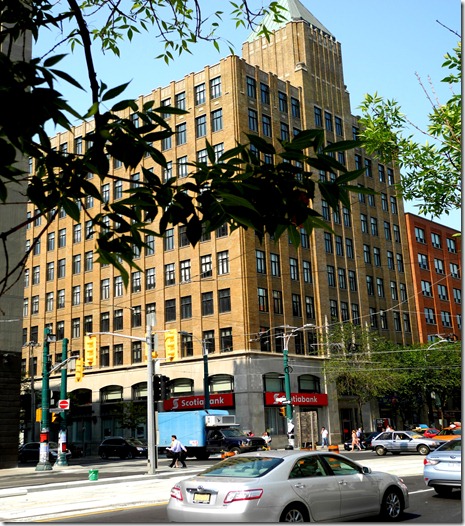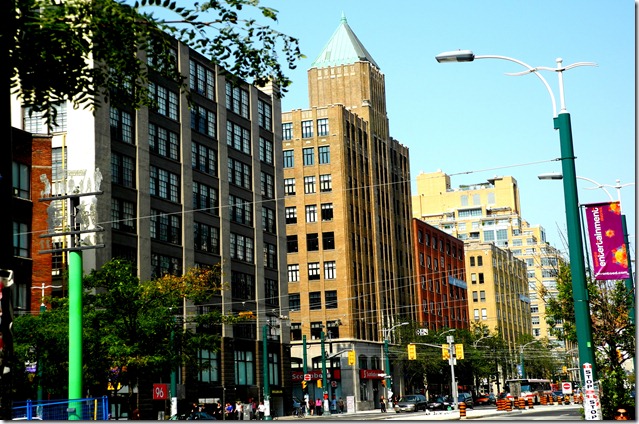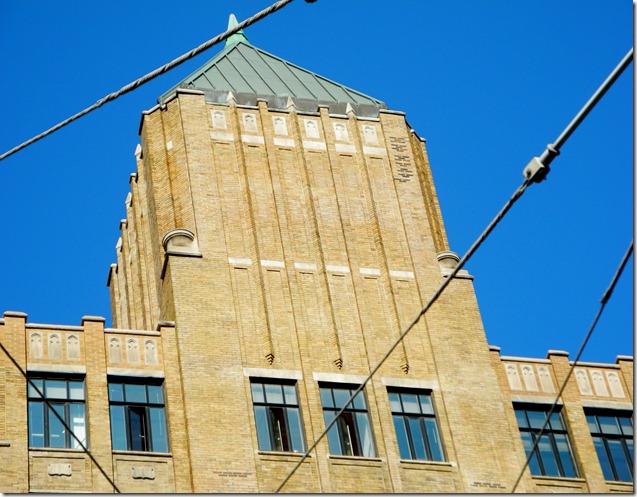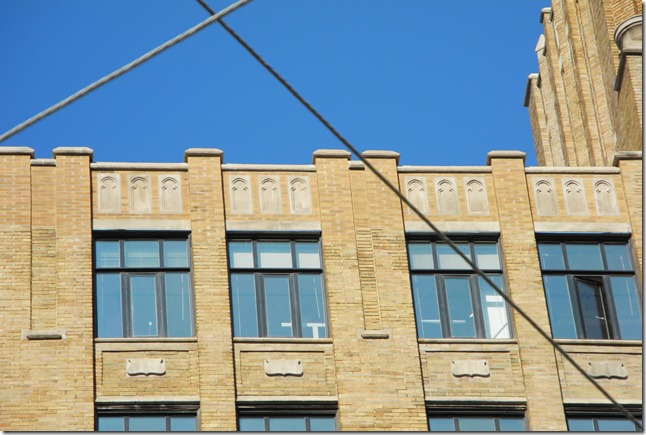The ten-storey Art Deco-style Tower Building at 106-110 Spadina Avenue, on the northwest corner of Adelaide and Spadina Avenue, is today a landmark structure in the Fashion District. Erected in 1927 by the Oxford Clothing Company, it was owned by the Poslun Brothers and C. James. They specialized in ladies clothing –cloaks, suits, and dresses. The Tower Building was designed by Benjamin Brown, who also designed the Balfour Building on the opposite side of the street, as well as the Standard (Victory Theatre). During the 1920s, Benjamin Brown designed nine buildings on Spadina Avenue.
The Tower Building is a loft structure, each of its ten-story floors originally designed as open spaces to enable the company to divide each floor into separate areas to accommodate various needs. At the time, this was a new concept in warehouse design. Some architectural historians refer to the ornamentation on the structure’s facades as neo-Gothic. The rows of tall rectangular windows, in vertical lines, on the east and south facades, accentuate the height of the building. The pyramidal tower at the top of the building, housing the maintenance equipment, is its crowning glory. The building’s height, with its Gothic ornamentation, the Tower Building was an impressive sight in 1920s Toronto, and it remains highly regarded today.
Tower Building, showing the south and east facades of the building
Art Deco structures on the west side of Spadina. On the left is the Darling Building, beside it is the Tower Building, then the Reading and the Fashion Buildings. In the distance is a modern condo, the Morgan, which nicely complements the 1920s buildings on Spadina, especially the Tower Building.
The two-storey tower on the top of the Tower Building that houses the building’s maintenance equipment.
Architectural details on the top of the Tower Building, on the east-facing facade, next to the tower.
To View the Home page for this blog: https://tayloronhistory.com/
Links to other posts about the history of Toronto and its buildings:
https://tayloronhistory.com/2013/10/08/links-to-historic-architecture-of-torontotayloronhistory-com/
Links to posts about Toronto’s movie houses—past and present.
https://tayloronhistory.com/2013/10/09/links-to-toronto-old-movie-housestayloronhistory-com/
Recent publication entitled “Toronto’s Theatres and the Golden Age of the Silver Screen,” by the author of this blog. The publication explores 50 of Toronto’s old theatres and contains over 80 archival photographs of the facades, marquees and interiors of the theatres. It also relates anecdotes and stories from those who experienced these grand old movie houses.
To place an order for this book:
Theatres Included in the Book
Chapter One – The Early Years—Nickelodeons and the First Theatres in Toronto
Theatorium (Red Mill) Theatre—Toronto’s First Movie Experience and First Permanent Movie Theatre, Auditorium (Avenue, PIckford), Colonial Theatre (the Bay), thePhotodome, Revue Theatre, Picture Palace (Royal George), Big Nickel (National, Rio), Madison Theatre (Midtown, Capri, Eden, Bloor Cinema, Bloor Street Hot Docs), Theatre Without a Name (Pastime, Prince Edward, Fox)
Chapter Two – The Great Movie Palaces – The End of the Nickelodeons
Loew’s Yonge Street (Elgin/Winter Garden), Shea’s Hippodrome, The Allen (Tivoli), Pantages (Imperial, Imperial Six, Ed Mirvish), Loew’s Uptown
Chapter Three – Smaller Theatres in the pre-1920s and 1920s
Oakwood, Broadway, Carlton on Parliament Street, Victory on Yonge Street (Embassy, Astor, Showcase, Federal, New Yorker, Panasonic), Allan’s Danforth (Century, Titania, Music Hall), Parkdale, Alhambra (Baronet, Eve), St. Clair, Standard (Strand, Victory, Golden Harvest), Palace, Bedford (Park), Hudson (Mount Pleasant), Belsize (Crest, Regent), Runnymede
Chapter Four – Theatres During the 1930s, the Great Depression
Grant ,Hollywood, Oriole (Cinema, International Cinema), Eglinton, Casino, Radio City, Paramount, Scarboro, Paradise (Eve’s Paradise), State (Bloordale), Colony, Bellevue (Lux, Elektra, Lido), Kingsway, Pylon (Royal, Golden Princess), Metro
Chapter Five – Theatres in the 1940s – The Second World War and the Post-War Years
University, Odeon Fairlawn, Vaughan, Odeon Danforth, Glendale, Odeon Hyland, Nortown, Willow, Downtown, Odeon Carlton, Donlands, Biltmore, Odeon Humber, Town Cinema
Chapter Six – The 1950s Theatres
Savoy (Coronet), Westwood
Chapter Seven – Cineplex and Multi-screen Complexes
Cineplex Eaton Centre, Cineplex Odeon Varsity, Scotiabank Cineplex, Dundas Square Cineplex, The Bell Lightbox (TIFF)




![cid_E474E4F9-11FC-42C9-AAAD-1B66D852[1] cid_E474E4F9-11FC-42C9-AAAD-1B66D852[1]](https://tayloronhistory.com/wp-content/uploads/2014/09/cid_e474e4f9-11fc-42c9-aaad-1b66d8521_thumb40.jpg)

